Stand-Level Fuel Reduction Treatments and Fire Behaviour in Canadian Boreal Conifer Forests
Abstract
1. Introduction
2. Fuel-Treatment Design Standards
3. Fuel Characterization and Modeling Frameworks for Fuel Treatment Assessment
3.1. Fuel Characterization
3.1.1. Surface Fuel Load (SFL)
3.1.2. Canopy Base Height (CBH)
3.1.3. Canopy Fuel Load (CFL) and Canopy Bulk Density (CBD)
3.2. Crown Fire Modeling Frameworks for Fuel Treatment Assessment
3.2.1. Linked Van Wagner and Byram Models
3.2.2. Canadian Forest Fire Behaviour Prediction (FBP) System
3.2.3. Canadian Fire Effects Model (CanFIRE)
3.2.4. Crown Fire Initiation Spread (CFIS) System
3.2.5. Canadian Conifer Pyrometrics (CCP)
3.2.6. FIRETEC and QUIC-Fire
3.3. Assessing and Interpreting Fuel Treatment Effects
3.3.1. Subjective or Inconsistent Model Inputs
3.3.2. Model Sensitivity to Assumptions—Illustrative Examples
4. Observations of Fuel Treatment Effects—Experimental Fires and Wildfires
4.1. Wildfire—Northern Saskatchewan (Black Spruce)
4.2. Experimental Fire—Alaska (Black Spruce and White Spruce)
4.3. Experimental Fire—Northwest Territories (Black Spruce)
4.4. Experimental Fire—Red Earth Creek, Alberta (Black Spruce)
4.5. Experimental Fire—Pelican Mountain, Alberta (Black Spruce)
4.6. Experimental Fire—Northwest Territories (Jack Pine)
5. Fuel Treatment Assessment and Design—Challenges and Needs
5.1. Acknowledging the Limitations of Modelled and Observed Fire Behaviour
5.2. Interpreting Evidence and Confronting Uncertainties
6. Conclusions
Author Contributions
Funding
Acknowledgments
Conflicts of Interest
References
- Brandt, J.P. The extent of the North American boreal zone. Environ. Rev. 2009, 17, 101–161. [Google Scholar] [CrossRef]
- Van Wagner, C.E. Fire behaviour in northern conifer forests and shrublands. In The Role of Fire in Northern Circumpolar Ecosystems; Wein, R.W., MacLean, D.A., Eds.; Wiley: Chichester, UK, 1983; pp. 65–80. [Google Scholar]
- Rowe, J.S.; Scotter, G.W. Fire in the Boreal forest. Quat. Res. 1973, 3, 444–464. [Google Scholar] [CrossRef]
- Forestry Canada Fire Danger Group. Development and structure of the Canadian Forest Fire Behaviour Prediction System. Information Report ST-X-3; Forestry Canada, Science and Sustainable Development Directorate: Ottawa, ON, Canada, 1992. [Google Scholar]
- Lavoie, N. Variation in Flammability of Jack Pine/Black Spruce Forests with Time Since Fire in the Northwest Territories, Canada. Ph.D. Thesis, University of Alberta, Edmonton, AB, Canada, 2004. [Google Scholar]
- Beverly, J.L. Time since prior wildfire affects subsequent fire containment in black spruce. Int. J. Wildland Fire 2017, 26, 919–929. [Google Scholar] [CrossRef]
- Barney, R.J.; Van Cleve, K.; Schlentne, R. Biomass distribution and crown characteristics in two Alaskan Picea mariana ecosystems. Can. J. For. Res. 1978, 8, 36–41. [Google Scholar] [CrossRef]
- Dyrness, C.T.; Norum, R.A. The effects of experimental fires on black spruce forest floors in interior Alaska. Can. J. For. Res. 1983, 13, 879–893. [Google Scholar] [CrossRef]
- Van Wagner, C.V. Conditions for the start and spread of crown fire. Can. J. For. Res. 1977, 7, 23–34. [Google Scholar] [CrossRef]
- Chrosciewicz, Z. Foliar moisture content in four coniferous tree species of central Alberta. Can. J. For. Res. 1986, 16, 157–162. [Google Scholar] [CrossRef]
- Hroback, J.L. Effects of Thinning in Black Spruce Feathermoss Forests on Duff Moisture Content and Predicted Fire Behavior; Department of Environmental Science, Allegheny College: Meadville, PA, USA, 2004. [Google Scholar]
- Horschel, E.A. Using NEXUS to Assess the Effectiveness of Experimental Black Spruce Forest Fuel Breaks to Reduce Crown Fire Potential in Alaska; Independent Research; University of Alaska Fairbanks: Fairbanks, AK, USA, 2007. [Google Scholar]
- Johnson, E.A. Fire and Vegetation Dynamics: Studies from the North American Boreal Forest; Cambridge University Press: Cambridge, UK, 1992. [Google Scholar]
- Arsenault, D. Impact of fire behaviour on postfire forest development in a homogenous Boreal landscape. Can. J. For. Res. 2001, 31, 1367–1374. [Google Scholar] [CrossRef]
- Brassard, B.W.; Chen, H.Y.H. Stand structural dynamics of North American Boreal forests. Crit. Rev. Plant Sci. 2006, 25, 115–137. [Google Scholar] [CrossRef]
- Agee, J.K. Fire Ecology of Pacific Northwest Forests; Island Press: Washington, DC, USA, 1993; pp. 338–350. [Google Scholar]
- Alexander, M.E.; Stefner, C.N.; Mason, J.A.; Stocks, B.J.; Hartley, G.R.; Maffey, M.E.; Wotton, B.M.; Taylor, S.W.; Lavoie, N.; Dalrymple, G.N. Characterizing the Jack Pine–Black Spruce Fuel Complex of the International Crown Fire Modelling Experiment (ICFME); Canadian Forest Service, Northern Forestry Centre: Edmonton, AB, Canada, 2004; NOR-X-393. [Google Scholar]
- MNP LLP. A Review of the 2016 Horse River Wildfire Alberta Agriculture and Forestry Preparedness and Response. 2017, pp. 1–92. Available online: https://www.alberta.ca/assets/documents/Wildfire-MNP-Report.pdf (accessed on 15 May 2020).
- Pyne, S.J. Introduction to Wildland Fire; Wiley: New York, NY, USA, 1984. [Google Scholar]
- Partners in Protection. FireSmart: Protecting Your Community from Wildfire; Partners in Protection: Edmonton, AB, Canada, 1999. [Google Scholar]
- Partners in Protection. FireSmart: Protecting Your Community from Wildfire, 2nd ed.; Partners in Protection: Edmonton, AB, Canada, 2003. [Google Scholar]
- Hirsch, K.; Kafka, V.; Tymstra, C.; McAlpine, R.; Hawkes, B.; Stegehuis, H.; Quintilio, S.; Gauthier, S.; Peck, K. Fire-smart forest management: A pragamatic approach to sustainable forest management in fire-dominated ecosystems. For. Chron. 2001, 77, 357–363. [Google Scholar] [CrossRef]
- Agee, J.K.; Bahro, B.; Finney, M.A.; Omi, P.N.; Sapsis, D.B.; Skinner, C.N.; van Wagtendonk, J.W.; Weatherspoon, C.P. The use of shaded fuelbreaks in landscape fire management. For. Ecol. Manag. 2000, 127, 55–66. [Google Scholar] [CrossRef]
- Butler, B.W.; Ottmar, R.D.; Rupp, T.S.; Jandt, R.; Miller, E.; Howard, K.; Schmoll, R.; Theisen, S.; Vihnanek, R.E.; Jimenez, D. Quantifying the effect of fuel reduction treatments on fire behaviour in Boreal forests. Can. J. For. Res. 2013, 43, 97–102. [Google Scholar] [CrossRef]
- Agee, J.K. The influence of forest structure on fire behaviour. In Proceedings of the 17th Annual Forest Vegetation Management Conference, Redding, CA, Canada, 16–18 January 1996; pp. 52–68. [Google Scholar]
- Graham, R.T.; McCaffrey, S.; Jain, T.B. Science Basis for Changing Forest Structure to Modify Wildfire Behaviour and Severity; Gen. Tech. Rep. RMRS-GTR-120; U.S. Department of Agriculture, Forest Service, Rocky Mountain Research Station: Fort Collins, CO, USA, 2004; 43p. [Google Scholar]
- Hvenegaard, S.; Price, L. Fire Behaviour in Mulch Fuel Beds: Observations from Experimental Fires at Pelican Mountain; Technical Report No. 43; FPInnovations Wildfire Operations Research Group: Pointe-Claire, QC, Canada, 2018; 15p. [Google Scholar]
- Wilkinson, S.L.; Moore, P.A.; Thompson, D.K.; Wotton, B.M.; Hvenegaard, S.; Schroeder, D.; Waddington, J.M. The effects of black spruce fuel management on surface fuel condition and peat burn severity in an experimental fire. Can. J. For. Res. 2018, 48, 1433–1440. [Google Scholar] [CrossRef]
- Rothermel, R.C. A Mathematical Model for Predicting Fire Spread in Wildland Fuels; Research Paper INT-115; USDA Forest Service, Intermountain Forest and Range Experiment Station: Ogden, UT, USA, 1972. [Google Scholar]
- van Wagtendonk, J.W. Use of a deterministic fire growth model to test fuel treatments. In Sierra Nevada Ecosystem Project: Final Report to Congress, Assessments and Scientific Basis for Management Options; Centers for Water and Wildland Resources, University of California: Davis, CA, USA, 1996; pp. 1155–1165. [Google Scholar]
- Countryman, C.M. Heat and Wildland Fire, Part 3: Heat Conduction and Wildland Fire; USDA Forest Service, Pacific Southwest Forest and Range Experiment Station: Berkeley, CA, USA, 1977; 17p. [Google Scholar]
- Sullivan, A.L. Inside the Inferno: Fundamental Processes of Wildland Fire Behaviour. Part 1: Combustion chemistry and heat release. Curr. For. Rep. 2017, 3, 132–149. [Google Scholar] [CrossRef]
- Byram, G.M. Combustion of forest fuels. In Forest Fire: Control and Use; Davis, K.P., Ed.; McGraw-Hill: New York, NY, USA, 1959; pp. 61–89. [Google Scholar]
- Murphy, P.J.; Woodard, P.M.; Titus, S.J. Exploratory analysis of the variables affecting initial attack hot-spotting containment rate. Can. J. For. Res. 1991, 21, 540–544. [Google Scholar] [CrossRef]
- Hirsch, K.G.; Corey, P.N.; Martell, D.L. Using expert judgment to model initial attack fire crew effectiveness. For. Sci. 1998, 44, 539–549. [Google Scholar]
- Hirsch, K.G.; Podur, J.J.; Janser, R.F.; McAlpine, R.S.; Martell, D.L. Productivity of Ontario initial-attack fire crews: Results of an expert judgement elicitation study. Can. J. For. Res. 2004, 34, 705–715. [Google Scholar] [CrossRef]
- Hirsch, K.G.; Pengelly, I. Fuel reduction in lodgepole pine stands in Banff National Park. In Proceedings of the Joint Fire Science Conference and Workshop, Boise, ID, USA, 15–17 June 1999; Neuenschwander, L.F., Ryan, K.C., Gollberg, G.E., Greer, J.D., Eds.; University of Idaho and International Association of Wildland Fire, 2000; pp. 251–256. [Google Scholar]
- Hvenegaard, S. National Wildland Fuels Management Survey (Revised); Contract Report CR-729(R); FPInnovations Wildfire Operations Research Group: Pointe-Claire, QC, Canada, 2012; 51p. [Google Scholar]
- Canadian Wildland Fire Strategy Assistant Deputy Ministers Task Group. Canadian wildland fire strategy: a vision for an innovative and integrated approach to managing the risks: A report submitted to the Canadian Council of Forest Ministers; Canadian Forest Service: Edmonton, AB, Canada, 2005; 18p. [Google Scholar]
- Filmon, G. British Columbia 2003 Firestorm. Provincial Review. Government of the Province of British Columbia, Victoria, British Columbia, Canada. 2004. Available online: http://bcwildfire.ca/History/ReportsandReviews/2003/FirestormReport.pdf (accessed on 15 May 2020).
- KPMG. Alberta Fire Review ’98 Final Report. Prepared for Alberta Forest Protection Advisory Committee. 13 December 1999. Available online: http://www.assembly.ab.ca/lao/library/egovdocs/1999/alen/128137.pdf (accessed on 15 May 2020).
- Chisholm Fire Review Committee. Chisholm Fire Review Committee Final Report; Chisholm Fire Review Committee: Edmonton, AB, Canada, 2001; Available online: https://open.alberta.ca/publications/2552904 (accessed on 15 May 2020).
- Flat Top Complex Wildfire Review Committee. Flat Top Complex: Final Report from the Flat Top Complex Wildfire Review Committee. Alberta Ministry of Environment and Sustainable Resource Development, May 2012, Edmonton, Alberta. 55 p + Appendices. Available online: https://open.alberta.ca/publications/9781460102732 (accessed on 15 May 2020).
- FRIAA. Forest Resource Improvement Association of Alberta 2018–2019 Annual Report. 2019. Available online: https://friaa.ab.ca/documents/2018-2019-annual-report/ (accessed on 15 May 2020).
- Government of Yukon. FireSmart Project Prepare and Protect Yukon Communities. News Release # 19-002. 2019. Available online: https://yukon.ca/en/news/firesmart-projects-prepare-and-protect-yukon-communities (accessed on 15 May 2020).
- UBCM. Strategic Wildfire Prevention Initiative Summary of Funded Applicants, 2011–2019; Union of British Columbia Municipalities: Richmond, BC, Canada, 2020. [Google Scholar]
- Indigenous Services Canada. Government of Canada Announces New investments in Wildfire Protection for First Nations Communities. News Release, 14 August 2019. [Google Scholar]
- Forest Practices Board. Fuel Management in the Wildland Urban Interface—Update; Forest Practices Board: Victoria, BC, Canada, May 2015. [Google Scholar]
- Abbott, G.; Chapman, M. A Report for Government and British Columbians—Addressing the New Normal: 21st Century Disaster Management in British Columbia. 2018. Available online: https://www2.gov.bc.ca/assets/gov/public-safety-and-emergency-services/emergency-preparedness-response-recovery/embc/bc-flood-and-wildfire-review-addressing-the-new-normal-21st-century-disaster-management-in-bc-web.pdf (accessed on 15 May 2020).
- Kalies, E.L.; Yocom Kent, L.L. Tamm Review: Are fuel treatments effective at achieving ecological and social objectives? A systematic review. For. Ecol. Manag. 2016, 375, 84–95. [Google Scholar] [CrossRef]
- Ontario Ministry of Natural Resources. Wildland Fire Assessment and Mitigation Reference Manual in Support of Provincial Policy Statement, 2014; Queen’s Printer for Ontario: Toronto, NO, Canada, April 2017; 80p. [Google Scholar]
- Schroeder, D. Fire behaviour in thinned Jack pine: Two case studies of FireSmart treatments in Canada’s Northwest Territories. FPInnovations Advantage Report; FPInnovations: Pointe-Claire, QC, Canada, 2010; Volume 12, 12p. [Google Scholar]
- Hvenegaard, S.; Schroeder, D.; Thompson, D. Fire behaviour in black spruce forest fuels following mulch fuel treatments: A case study at Red Earth Creek, Alberta. Technical Report 42; FPInnovations: Pointe-Claire, QC, Canada, 2016. [Google Scholar]
- Hvenegaard, S. Fuel Treatment Intensity and Fire Behaviour: Experimental Fires in Mulched Fuels at Pelican Mountain; FPInnovations Wildfire Operations Research Group: Pointe-Claire, QC, Canada, 2020; 11p. [Google Scholar]
- Cameron, H. Predicting Fuel Characteristics of Black Spruce Stands Using Airborne Laser Scanning (ALS) in the Province of Alberta, Canada. Master’s Thesis, University of Alberta, Edmonton, AB, Canada, 2020; 122p. [Google Scholar]
- Keane, R.E. Describing wildland surface fuel loading for fire management: A review of approaches, methods and systems. Int. J. Wildl. Fire 2013, 22, 51–62. [Google Scholar] [CrossRef]
- Sandberg, D.V.; Ottmar, R.D.; Cushon, G.H. Characterizing fuels in the 21st century. Int. J. Wildl. Fire 2001, 10, 381–387. [Google Scholar] [CrossRef]
- Cruz, M.G.; Alexander, M.E.; Wakimoto, R.H. Modeling the likelihood of crown fire occurrence in conifer forest stands. For. Sci. 2004, 50, 640–658. [Google Scholar]
- de Groot, W.; Pritchard, J.; Lynham, T. Forest floor fuel consumption and carbon emissions in Canadian Boreal forest fires. Can. J. For. Res. 2009, 39, 367–382. [Google Scholar] [CrossRef]
- McRae, D.J.; Alexander, M.E.; Stocks, B.J. Measurement and Description of Fuels and Fire Behaviour on Prescribed Burns: A Handbook (Report 0-X-287); Canadian Forest Service, Great Lakes Forest Research Centre: Sault Ste. Marie, ON, Canada, 1979. [Google Scholar]
- Letang, D.L.; de Groot, W.J. Forest floor depths and fuel loads in upland Canadian forests. Can. J. For. Res. 2012, 42, 1551–1565. [Google Scholar] [CrossRef]
- Cruz, M.G.; Alexander, M.E.; Wakimoto, R.H. Assessing canopy fuel stratum characteristics in crown fire prone fuel types of western North America. Int. J. Wildl. Fire 2003, 12, 39–50. [Google Scholar] [CrossRef]
- Cruz, M.G. Modeling the Initiation and Spread of Crown Fires. Master’s Thesis, University of Montana, Missoula, MT, USA, 1999; 162p. [Google Scholar]
- Scott, J.H.; Reinhardt, E.D. Assessing Crown Fire Potential by Linking Models of Surface and Crown Fire Behavior; Res. Pap. RMRS-RP-29; US Department of Agriculture, Forest Service, Rocky Mountain Research Station: Fort Collins, CO, USA, 2001; 59p. [Google Scholar]
- Cruz, M.G.; Alexander, M.E. Assessing crown fire potential in coniferous forests of western North America: A critique of current approaches and recent simulation studies. Int. J. Wildl. Fire 2010, 19, 377–398. [Google Scholar] [CrossRef]
- Stocks, B.J.; Alexander, M.E.; Wotton, B.M.; Stefner, C.N.; Flannigan, M.D.; Taylor, S.W.; Lavoie, N.; Mason, J.A.; Hartley, G.R.; Maffey, M.E.; et al. Crown fire behaviour in a northern jack pine-black spruce forest. Can. J. For. Res. 2004, 34, 1548–1560. [Google Scholar] [CrossRef]
- Alexander, M.E.; Cruz, M.G. Tables for estimating canopy fuel characteristics from stand variables in four interior west conifer forest types. For. Sci. 2014, 60, 784–794. [Google Scholar] [CrossRef]
- Stocks, B.J. Black spruce crown fuel weights in northern Ontario. Can. J. For. Res. 1980, 10, 498–501. [Google Scholar] [CrossRef]
- Scott, J.H. Comparison of Crown Fire Modeling Systems Used in Three Fire Management Applications; USDA Forest Service, Rocky Mountain Research Station: Fort Collins, CO, USA, 2006. [Google Scholar]
- Van Wagner, C.E. Development and Structure of the Canadian Forest Fire Weather Index System; Technical Report 25; Canadian Forest Service: Ottawa, ON, Canada, 1987. [Google Scholar]
- de Groot, W.J.; Bothwell, P.M.; Carlsson, D.J.L.; Logan, K. Simulating the impacts of future fire regimes and fire management strategies on vegetation and fuel dynamics in western Canada using a Boreal fire effects model (BORFIRE). In Forest Fire Research and Wildland Fire Safety; Viegas, D.X., Ed.; Millpress: Rotterdam, The Netherlands, 2002. [Google Scholar]
- de Groot, W.J. Modeling fire effects: Integrating fire behaviour and fire ecology. In Proceedings of the VI International Conference on Forest Fire Research, ADAI/CEIF, Coimbra, Portugal, 15–18 November 2010. [Google Scholar]
- Cruz, M.G.; Alexander, M.E.; Wakimoto, R.H. Development and testing of models for predicting crown fire rate of spread in conifer forest stands. Can. J. For. Res. 2005, 35, 1626–1639. [Google Scholar] [CrossRef]
- Alexander, M.E.; Cruz, M.G.; Lopes, A.M.G. CFIS: A software tool for simulating crown fire initiation and spread. In Proceedings of the 5th International Conference Forest Fire Research, Figueira da Foz, Portugal, 27–30 November 2006; Viegas, D.X., Ed.; Elsevier B.V.: Amsterdam, The Netherlands, 2006. 13p. [Google Scholar]
- Wotton, B.M.; Beverly, J.L. Stand-specific litter moisture content calibrations for the Canadian Fine Fuel Moisture Code. Int. J. Wildland Fire 2007, 16, 463–472. [Google Scholar] [CrossRef]
- Perrakis, D.D.B.; Cruz, M.G.; Alexander, M.E.; Taylor, S.W.; Beverly, J.L. Linking Dynamic Empirical Fire Spread Models: Introducing Canadian Conifer Pyrometrics. In Proceedings of the 6th International Fire Behaviour and Fuels Conference, Marseille, France, 29 April–3 May 2019; Preprint. 7pAvailable online: https://www.researchgate.net/publication/336013042_Linking_Dynamic_Empirical_Fire_Spread_Models_Introducing_Canadian_Conifer_Pyrometrics (accessed on 15 May 2020).
- Rothermel, R.C. How to Predict the Spread and Intensity of Forest and Range Fires; Gen. Tech. Rep. INT-143; USDA For. Serv., Intermountain Forest and Range Experiment Station: Ogden, UT, USA, 1983; 161p. [Google Scholar]
- Linn, R. A Transport Model for Prediction of Wildfire Behaviour (No. LA-13334-T); Los Alamos National Lab.: New Mexico, NM, USA, 1997. [Google Scholar]
- Linn, R.; Anderson, K.; Winterkamp, J.; Brooks, A.; Wotton, M.; Dupuy, J.-L.; Pimont, F.; Edminster, C. Incorporating field wind data into FIRE-TEC simulations of the International Crown Fire Modeling Experiment (ICFME): Preliminary lessons learned. Can. J. For. Res. 2012, 42, 879–898. [Google Scholar] [CrossRef]
- Marshall, G.; Thompson, D.K.; Anderson, K.; Simpson, B.; Linn, R.; Schroeder, D. The Impact of Fuel Treatments on Wildfire Behaviour 2 in North America Boreal Fuels: A Simulation Study 3 Using FIRETEC. Fire 2020, 3, 18. [Google Scholar] [CrossRef]
- Linn, R.R.; Goodrick, S.L.; Brambilla, S.; Brown, M.J.; Middleton, R.S.; O’Brien, J.J.; Hiers, J.K. QUIC-fire: A fast-running simulation tool for prescribed fire planning. Environ. Model. Softw. 2020, 125, 104616. [Google Scholar] [CrossRef]
- Ottmar, R.D.; Sandberg, D.V.; Riccardi, C.L.; Prichard, S.J. An overview of the Fuel Characteristic Classification System—quantifying, classifying, and creating fuelbeds for resource planning. Can. J. For. Res. 2007, 37, 2383–2393. [Google Scholar] [CrossRef]
- Riccardi, C.L.; Ottmar, R.; Sandberg, D.V.; Andreu, A.; Elman, E.; Kopper, K.; Long, J. The fuelbed: A key element of the Fuel Characteristic Classification System. Can. J. For. Res. 2007, 37, 2394–2412. [Google Scholar] [CrossRef]
- Moore, B.; Thompson, D.K.; Schroeder, D.; Johnston, J.; Hvenegaard, S. Using infrared imagery to assess fire behaviour in a mulched fuel bed in black spruce forests. Fire 2020, in press. [Google Scholar]
- Schiks, T.; Thompson, D.K.; Wotton, B.M. Short-term effects of mastication on fuel moisture and thermal regime of boreal fuel beds. Can. J. For. Res. 2015, 45, 867–876. [Google Scholar] [CrossRef]
- Government of Saskatchewan. Case Study: How Fuel Treatment Areas Affect Wildland Urban Interface Fires; Report; Government of Saskatchewan: Saskatchewan, SK, Canada, 2014; 17p. [Google Scholar]
- Mooney, C. Can light stand thinning weaken an advancing crown fire? A case study in Black Spruce (Picea mariana). FPInnovations Final Report; FPInnovations: Pointe-Claire, QC, Canada, 2013; 10p. [Google Scholar]
- Thompson, D.K.; Schroeder, D.; Wilkinson, S.L.; Barber, Q.; Baxter, G.; Cameron, H.; Hsieh, R.; Marshall, G.; Moore, B.; Refai, R.; et al. Recent crown thinning in a boreal black spruce forest reduces fire intensity but not spread rate: Results from an experimental fire in Alberta, Canada. Fire 2020, 3, 28. [Google Scholar] [CrossRef]
- Deane, P.J.; Wilkinson, S.L.; Moore, P.A.; Waddington, J.M. Seismic Lines in Treed Boreal Peatlands as Analogs for Wildfire Fuel Modification Treatments. Fire 2020, 3, 21. [Google Scholar] [CrossRef]
- Baxter, G.; Ault, R. Fuel load and surface fire behaviour differences between an eight-year-old forest fuel treatment and a natural stand. FPInnovations Wildfire Operations Research; Project Note; FPInnovations: Pointe-Claire, QC, Canada, 2013; 5p. [Google Scholar]
- Baxter, G.; Sharpe, M. Underburning NWT August 2017. FPInnovations Technical Report No. 59; FPInnovations: Pointe-Claire, QC, Canada, 2017; 20p. [Google Scholar]
- Kasischke, E.S.; Turetsky, M.R.; Ottmar, R.D.; French, N.H.F.; Hoy, E.H.; Kane, E.S. Evaluation of the composite burn index for assessing fire severity in Alaskan black spruce forests. Int. J. Wildl. Fire 2008, 17, 515–526. [Google Scholar] [CrossRef]
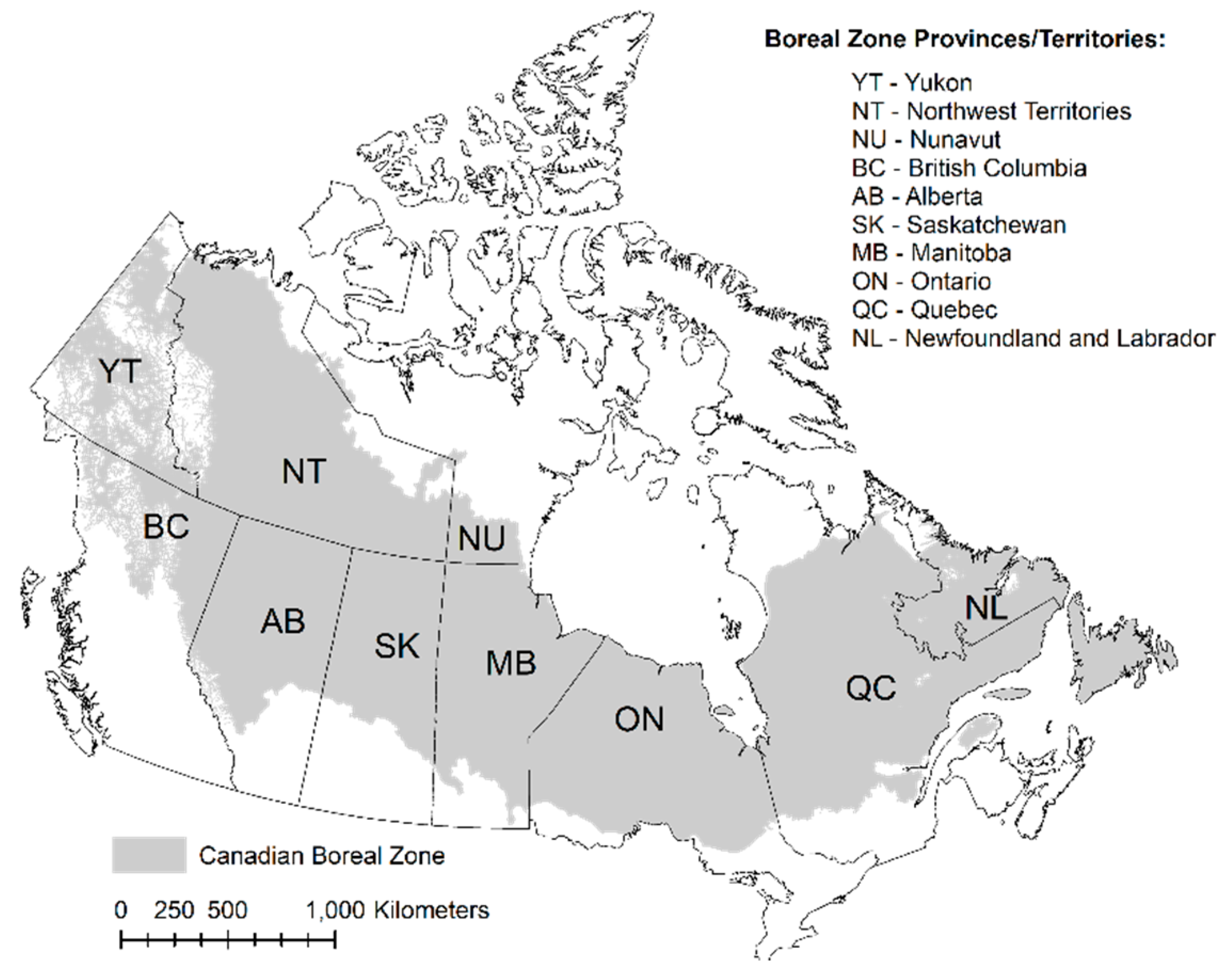
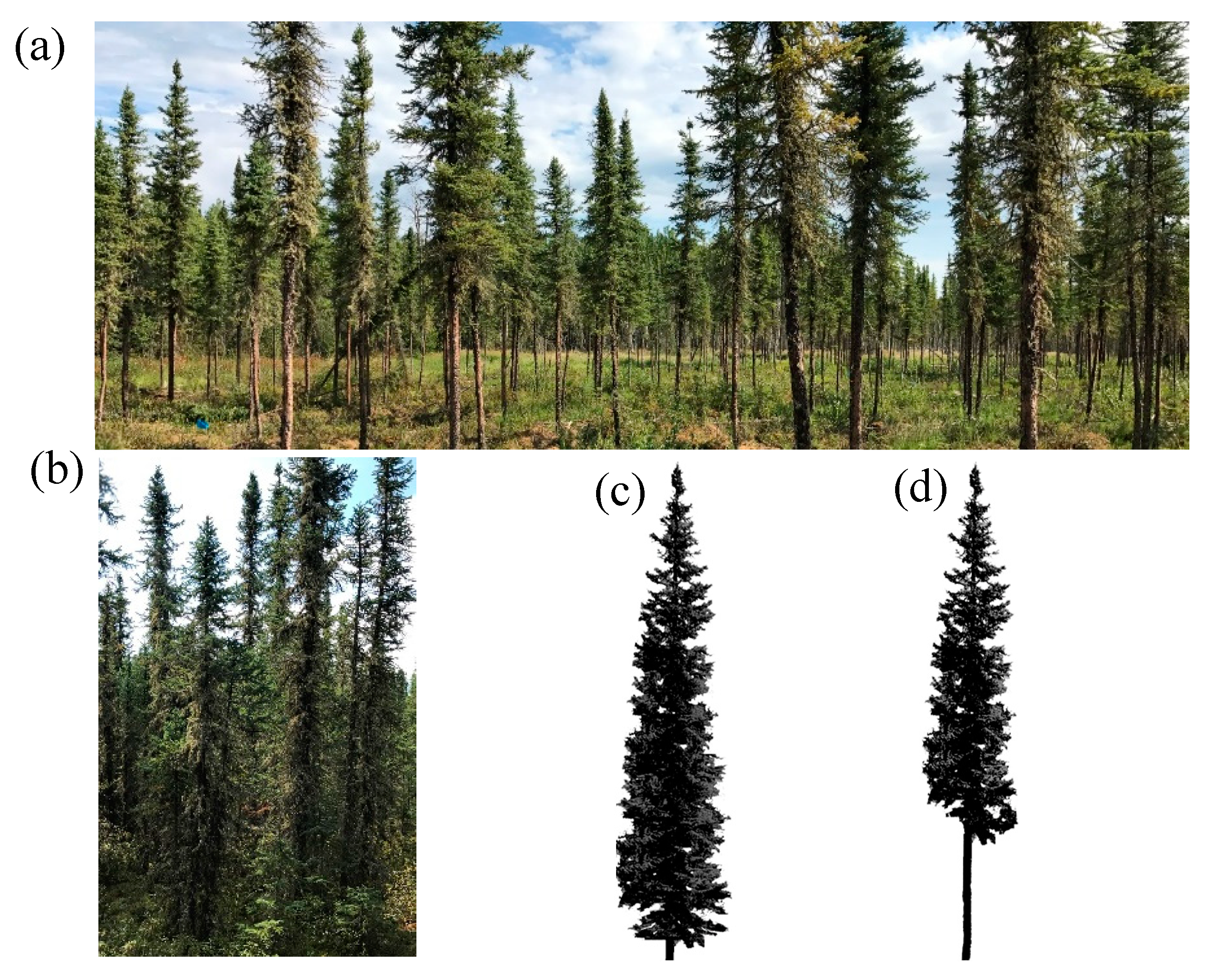
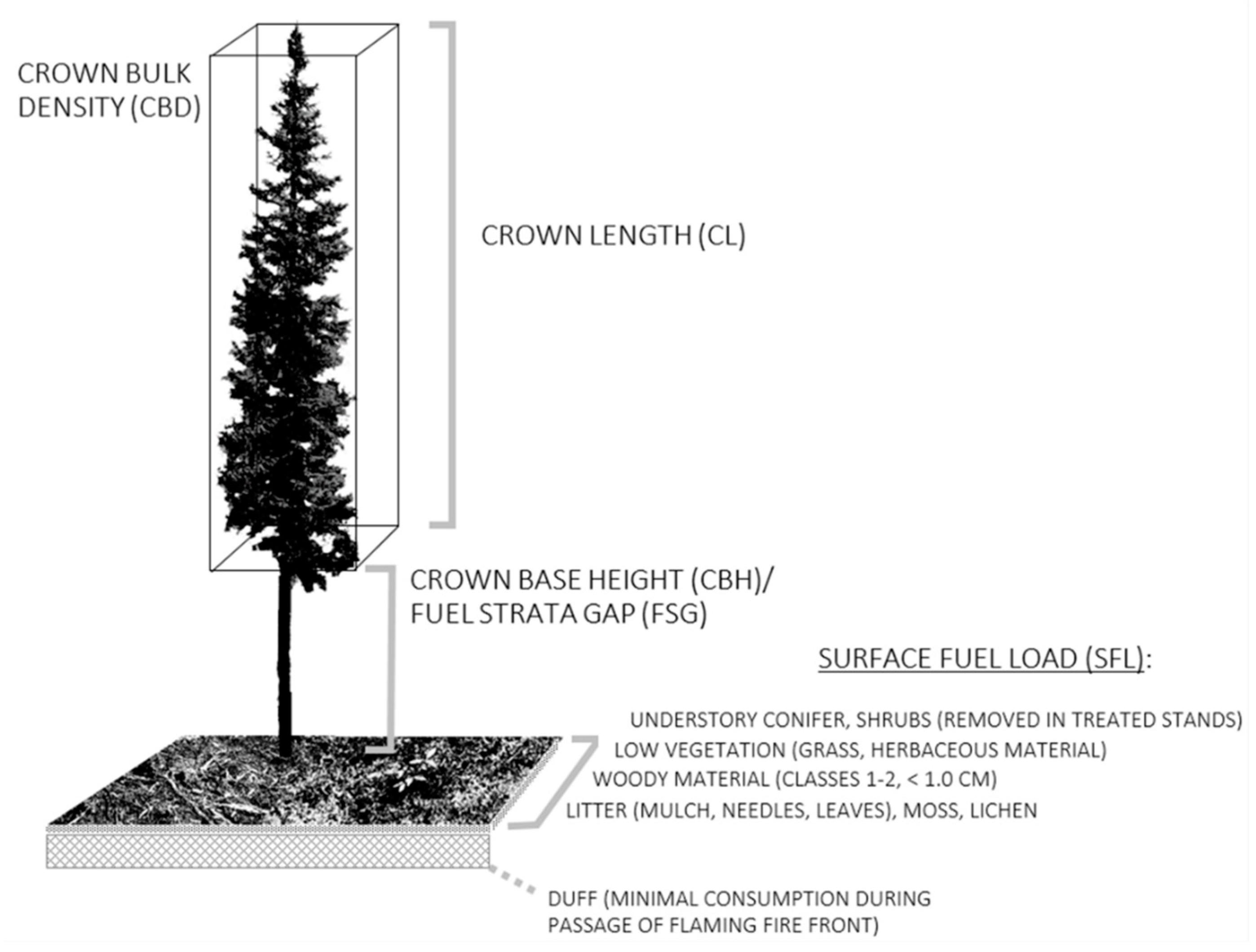
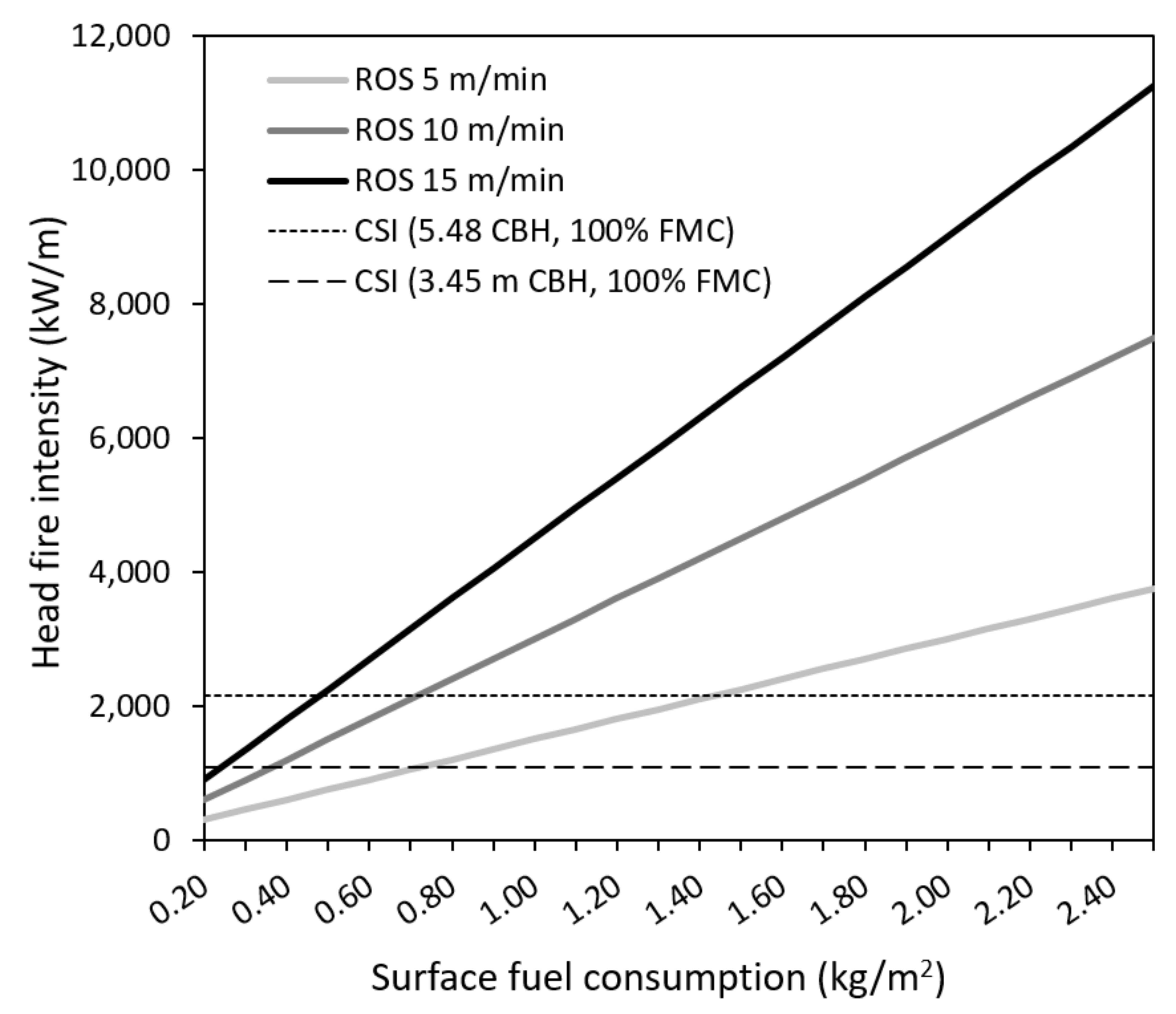
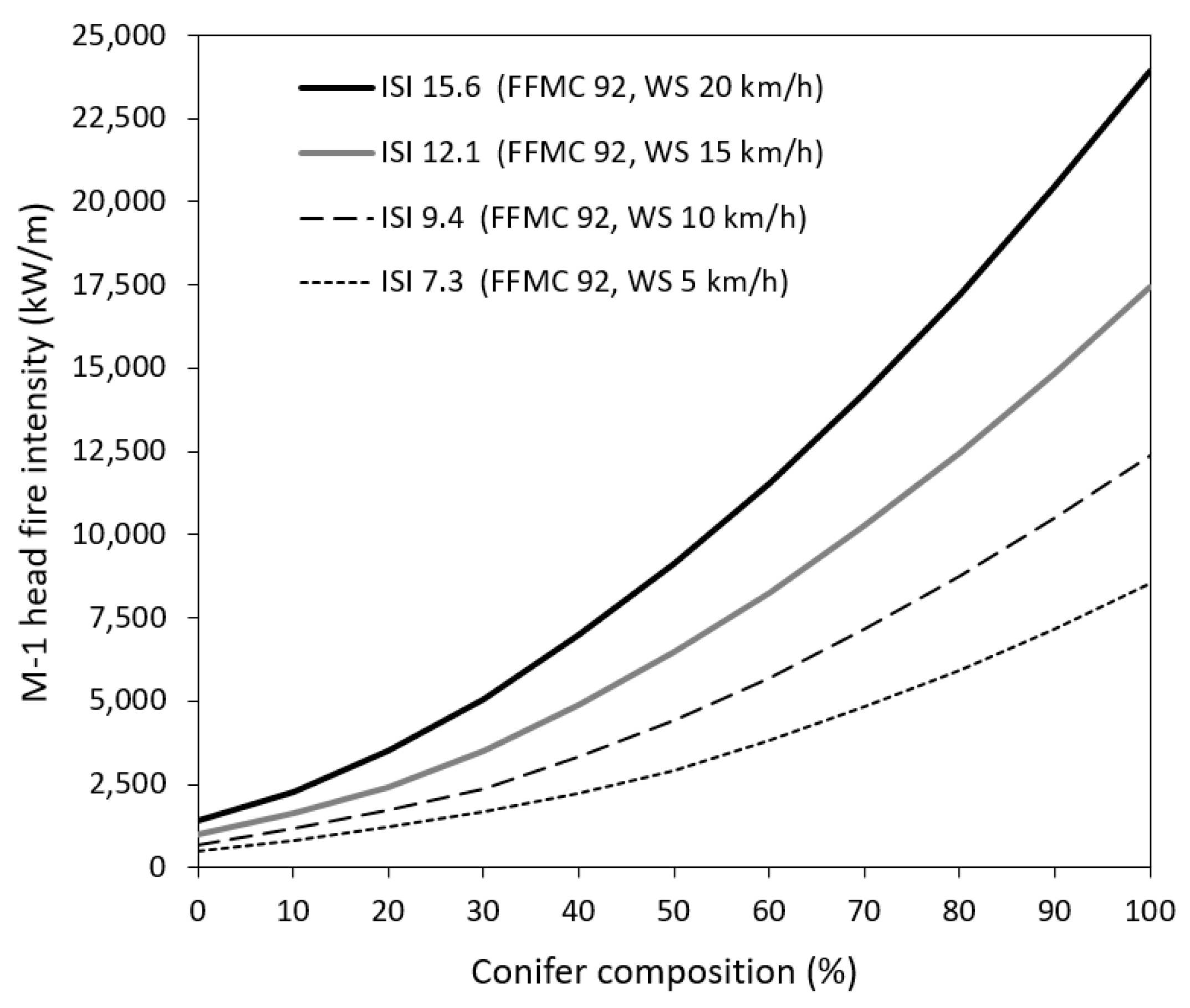
© 2020 by the authors. Licensee MDPI, Basel, Switzerland. This article is an open access article distributed under the terms and conditions of the Creative Commons Attribution (CC BY) license (http://creativecommons.org/licenses/by/4.0/).
Share and Cite
Beverly, J.L.; Leverkus, S.E.R.; Cameron, H.; Schroeder, D. Stand-Level Fuel Reduction Treatments and Fire Behaviour in Canadian Boreal Conifer Forests. Fire 2020, 3, 35. https://doi.org/10.3390/fire3030035
Beverly JL, Leverkus SER, Cameron H, Schroeder D. Stand-Level Fuel Reduction Treatments and Fire Behaviour in Canadian Boreal Conifer Forests. Fire. 2020; 3(3):35. https://doi.org/10.3390/fire3030035
Chicago/Turabian StyleBeverly, Jennifer L., Sonja E. R. Leverkus, Hilary Cameron, and Dave Schroeder. 2020. "Stand-Level Fuel Reduction Treatments and Fire Behaviour in Canadian Boreal Conifer Forests" Fire 3, no. 3: 35. https://doi.org/10.3390/fire3030035
APA StyleBeverly, J. L., Leverkus, S. E. R., Cameron, H., & Schroeder, D. (2020). Stand-Level Fuel Reduction Treatments and Fire Behaviour in Canadian Boreal Conifer Forests. Fire, 3(3), 35. https://doi.org/10.3390/fire3030035




